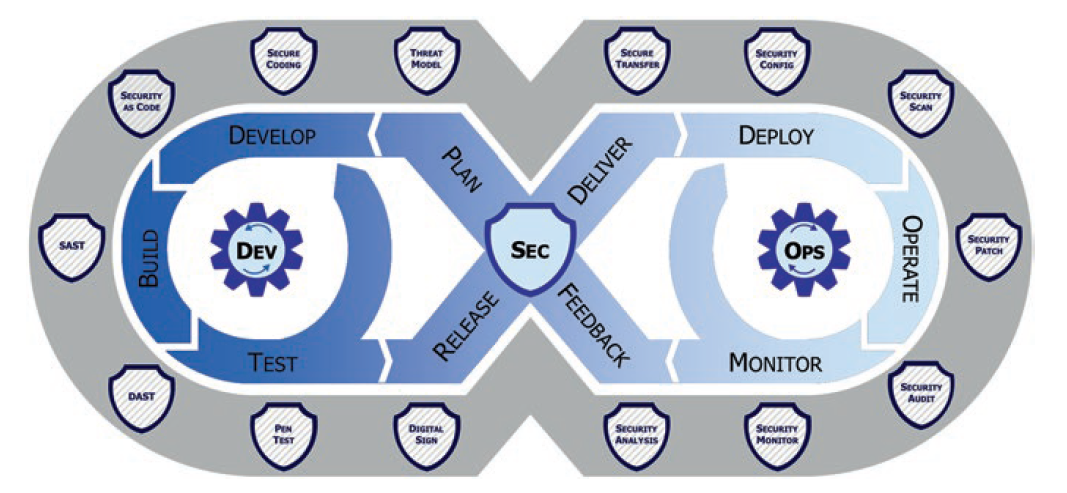In today's changing world of software development ensuring the security and reliability of applications has become more crucial than before. This is where DevSecOps comes into the picture. An approach that goes beyond software development practices. DevSecOps fosters a culture of collaboration, agility and security throughout the development lifecycle.
Understanding DevSecOps: A Holistic Approach
DevSecOps is not simply a set of practices; it's a philosophy that combines methodologies, cultures, tools and practices to enhance application security and reliability. Its primary objective is to speed up application development while implementing security measures. By prioritizing security from the stages of development (also known as "security shift to the left") DevSecOps enables teams to identify and address security vulnerabilities before they turn into issues.
At the core of the DevSecOps methodology lies involvement from IT security teams. These teams play a role in integrating security controls into every step of the application development process – from gathering security requirements to designing, engineering and monitoring. Collaboration between development IT security and operations teams is key, in providing flexibility and transparency throughout the process.
Breaking Down Legacy Silos: Unifying Development, IT, and Security Teams
In many legacy IT environments, activities and responsibilities were traditionally segmented. Developers focused on coding, infrastructure teams managed system environments, and security teams often worked in isolation, addressing vulnerabilities late in the development cycle. This siloed approach hindered problem resolution and made it challenging to mitigate issues in the production environment.
DevSecOps challenges this legacy paradigm, advocating for a more integrated and collaborative model. The approach breaks down silos and encourages transparency and unity among development, IT, and security teams. By doing so, it addresses the shortcomings of the traditional waterfall development process, where each stage is sequential and isolated. The result is a more efficient and secure development cycle, with teams working together to deliver products in an optimized and transparent manner.
DevSecOps in Action: The Continuous and Circular Development Process

DevSecOps operates on a continuous and circular development process, in stark contrast to the linear waterfall approach. Security is integrated early in the planning and requirement phases, and tools like security scanning and monitoring are applied throughout development and operation stages. This agile and iterative process facilitates fast feedback loops, enabling the identification of security vulnerabilities early in the development process.
DevSecOps Implementation: Beyond Tools to Cultural Change
While the incorporation of security tools is essential in DevSecOps, it is equally crucial to recognize that effective security goes beyond the adoption of new technologies. The success of DevSecOps relies on cultural changes that integrate security into every stage of application development. This cultural shift fosters a mindset where security is not an isolated concern but an integral aspect of the entire development process.
Various strategies can be employed to incorporate security into DevSecOps. This includes implementing security tools in integrated development environments (IDEs) and application build pipelines. The option to break the build in case of highly vulnerable code commits ensures that security is not compromised for the sake of speed. Automating certain security activities becomes imperative to prevent hindering the development process.
Conclusion: Embracing the Future of Secure Application Development
DevSecOps marks a paradigm shift in the world of application development. It represents a departure from traditional, siloed approaches, advocating for collaboration, transparency, and early integration of security measures. As the digital landscape continues to evolve, the importance of secure and reliable applications cannot be overstated.
By adopting DevSecOps principles, development teams can deliver products faster, more securely, and with greater efficiency. The iterative and collaborative nature of DevSecOps ensures that security vulnerabilities are identified early, reducing the likelihood of security breaches. The cultural shift towards integrating security into every stage of development further solidifies the foundation for a more resilient and future-ready approach to application development.
In a world where cyber threats are ever-present, DevSecOps emerges as a beacon of innovation, paving the way for a secure and agile future in software development. As organizations embrace this transformative approach, they position themselves not only to meet the challenges of today but to thrive in the dynamic and ever-changing landscape of tomorrow.
For any custom software development services , it outsourcing services solutions visit our websites.


No comments yet